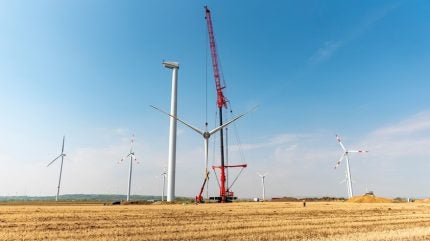
Across the world, ageing wind turbines are nearing the end of their lifespan, which begs the question of what happens to their components after they are decommissioned.
Wind turbines have a lifespan of between 20 and 30 years. The world’s first windfarm was erected in New Hampshire, US, in 1980 and was 20 turbines strong. It was followed by the first offshore windfarm in Vindeby, Denmark, in 1991, along with the first onshore windfarm in Cornwall, UK, also in 1991.
Since then, wind turbines have been erected across the world, heralded as a crucial part of the solution to the green transition. GlobalData estimates that there are currently over 329,000 active turbines worldwide, with almost 200,000 more in the pipeline.
What materials make a wind turbine?
The primary material in a wind turbine is steel, which is used for the tower, nacelle and foundation and can comprise anywhere between 66% and 79% of the materials present in the structure.
GlobalData analyst Harminder Singh explains: “Steel provides the necessary strength and rigidity to withstand substantial loads from wind and gravity, ensuring the structural integrity of the turbine.”
Fibreglass-reinforced polymer is the lightweight material used for the turbine blades. This material makes up between 11% and 16% of the turbine and offers qualities essential to the capture of energy – stiffness (for efficiency), aerodynamic design (to minimise drag) and lightweight construction.

US Tariffs are shifting - will you react or anticipate?
Don’t let policy changes catch you off guard. Stay proactive with real-time data and expert analysis.
By GlobalDataIron or cast iron makes up between 5% and 17% of a wind turbine and is used for components within the nacelle, while copper, accounting for 1%, is used for electrical wiring throughout the turbine. Singh explains that aluminium is also sometimes used in turbines as its lightweight properties can be useful in non-critical structural components.
What happens when a turbine is decommissioned?
Wind turbines are not always decommissioned immediately after their working life. Depending on their condition and functionality, they are sometimes refurbished or allowed to continue operating (albeit less efficiently) until they become economically unfeasible.
Decommissioning a wind turbine is not a straightforward process. The turbine must be disconnected from the grid, which requires permits and approvals from the relevant authorities and stakeholders. After this, the turbine must be removed from its site.
“Once the turbine is decommissioned, cranes and other equipment are used for the removal of the systems,” says Singh. “Some project infrastructure, like overhead lines, underground lines and substations, may be reused. Turbines are dismantled and the parts are removed. The blades, nacelle, or housing for components related to the generation of electricity and the tower are all fully removed from the site. Cables that are part of the collection system, as well as transformers, are also removed.
“Turbine foundations are removed so that land can be returned to an agricultural use. The majority of the turbine components, like concrete and metals, make their way to recycling plants, but many components like blades are disposed of at landfills.”
What happens to the materials?
Up to 95% of the materials in a wind turbine can be recycled. Steel, aluminium and copper are particularly straightforward. However, the fibreglass used in the blades is more complicated. The blades – usually over 100ft in length – are commonly disposed of in landfill sites.
Singh notes: “In the US, retired wind turbine blades are primarily sent to one of a small number of landfills that accept them in Iowa, South Dakota or Wyoming. This option is becoming increasingly less feasible with several countries, notably Germany and the Netherlands, banning the practice.”
Considering alternative disposal methods for fibreglass blades, Singh adds: “Nacelles and blades are generally made of fibreglass and are ground down to be used as fuel in cement factories or filler in road construction. Innovative solutions such as repurposing blades into playgrounds or bike sheds have been shown to be effective at a local level.”


